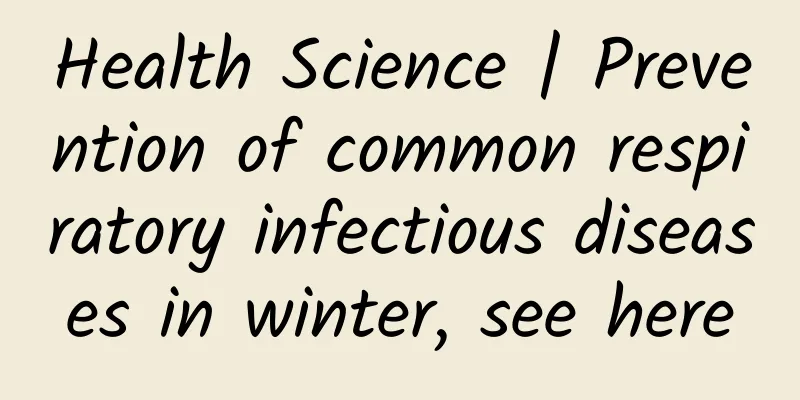Health Science | Prevention of common respiratory infectious diseases in winter, see here

|
Health Science | Prevention of common respiratory infectious diseases in winter, see here Tongling Disease Control 1. What are the common respiratory infectious diseases? Respiratory infectious diseases refer to infectious diseases caused by pathogens invading the respiratory tract. They are mainly transmitted by patients or infected persons through droplets. Different respiratory diseases have different clinical manifestations. Common respiratory infectious diseases in recent years include Mycoplasma pneumoniae infection, influenza, respiratory syncytial virus infection, adenovirus respiratory infection, and varicella. 2. Introduction to Common Respiratory Infectious Diseases 1. Influenza It is mainly caused by influenza A and B viruses and is highly contagious. Systemic symptoms such as high fever, headache, muscle aches, and fatigue are more severe. A few people have digestive tract symptoms such as nausea, vomiting, and diarrhea. The course of the disease generally lasts about 1 week. It is mainly transmitted through air droplets, and can also be transmitted through direct or indirect contact, as well as in the form of aerosols. Influenza vaccination is an effective way to prevent human influenza from becoming ill and spreading. 2. Mycoplasma pneumonia Pulmonary inflammation caused by Mycoplasma pneumoniae infection. Symptoms include fever and irritating dry cough, which may be accompanied by headache, runny nose, sore throat, etc. It is mainly transmitted through droplets, but can also be transmitted through contact. The incubation period is relatively long, averaging 2-3 weeks. People of all ages are generally susceptible, and children are a high-risk group, especially those over 5 years old. There is currently no targeted vaccine. 3. Respiratory syncytial virus infection Mild and early symptoms of RSV infection are similar to those of the common cold. In severe cases, patients may experience difficulty breathing or shortness of breath, wheezing, irritability, loss of appetite, etc. It is mainly transmitted through droplets and close contact. Infants and young children under 5 years old, especially those under 2 years old, are susceptible. It is mainly transmitted through droplets and close contact. The course of the disease generally lasts 1-2 weeks. There is currently no targeted vaccine. 4. Chickenpox is caused by the varicella-zoster virus. Symptoms include chills, low fever, headache, fatigue, cough, loss of appetite, and rash. Patients may develop papules, blisters, and scabs all over their bodies at the same time. The rash first appears on the trunk and then extends to the face and limbs. The source of infection is chickenpox patients. It is transmitted through respiratory droplets and direct contact, and can also be indirectly transmitted through contact with contaminated utensils. It is highly contagious and more common in children. The peak incidence is in winter and spring. Patients should be isolated from the respiratory tract until all herpes scabs have formed. They should rest in bed during the fever period and pay attention to replenishing water. Antiviral treatment can be carried out in the early stage according to the doctor's advice. Chickenpox vaccine can be administered for prevention. 5. Adenovirus respiratory tract infection The main symptoms are cough, nasal congestion and pharyngitis, accompanied by fever, chills, headache and muscle aches, etc. Pharyngitis, pharyngitis, conjunctivitis and pneumonia may also occur. It is mainly transmitted through droplets or touching contaminated objects without washing hands and touching the mouth, nose or eyes. It can also be transmitted through the fecal-oral route. It most often occurs in children aged 6 months to 5 years, especially children under 2 years old. The course of the disease generally lasts 1-2 weeks. There is currently no targeted vaccine. 3. How to effectively prevent it? 1. Practice healthy behaviors and lifestyles In daily life, we should actively advocate a healthy lifestyle, maintain adequate sleep, adequate nutrition, and proper physical exercise to achieve the goal of enhancing physical fitness and improving body resistance. 2. Vaccination Vaccination is the most economical and effective means to prevent infectious diseases. Schools are crowded places, and teachers, students and cohabitants should actively get vaccinated against influenza, chickenpox and other vaccines to build an immune barrier. 3. Wash your hands frequently Washing hands can reduce the risk of contact with pathogens and infection. Frequent hand washing is a very important habit for protecting against respiratory infectious diseases caused by influenza, especially after coughing or sneezing, before eating or after contact with contaminated environments. Pay attention to washing hands more often and thoroughly. 4. Ventilate frequently It is also very important to keep the home and workplace environment clean and well ventilated. Pay attention to cleaning the room and opening windows for ventilation. 5. Wear a mask. Respiratory infectious diseases are mainly transmitted through droplets. It is very important to wear a mask correctly. You must wear a mask when taking public transportation or entering crowded places such as shopping malls, supermarkets, and hospitals. 6. Avoid gathering during the peak season of the epidemic. Try to avoid going to crowded and poorly ventilated areas and avoid close contact with patients with respiratory infections. Try not to go to confined areas with poor air circulation. If you must go out, it is recommended to wear a mask, take good self-protection, and pay attention to changing it in time. 7. Maintain good respiratory hygiene habits When coughing or sneezing, be sure to cover your mouth and nose with a tissue or towel. Wash your hands promptly after coughing or sneezing, and try to avoid direct contact with your eyes, nose, mouth and other parts with your hands. Finally, please note that if you have symptoms such as fever, cough, sore throat, runny nose, etc., you should take the initiative to rest at home and not go to class or work while sick. Most respiratory infectious diseases are self-limiting and do not require antiviral treatment. Symptomatic treatment can cure the disease. However, it is recommended that the elderly, children under 5 years old, and special groups with low immunity seek medical attention in time to avoid worsening of the disease. |
<<: Why are respiratory infections particularly severe this winter?
>>: Night Listening|Does "right-angled shoulders" look good? It's not necessary
Recommend
Why is there brown discharge from the vagina?
Nowadays, the chances of women suffering from gyn...
Why do women sweat when they sleep?
Chest sweating is a common disease. Nowadays, mor...
The harm of vulvar hyperplastic leukoplakia
Nowadays, women are exposed to more and more bact...
Why can't celery leaves be eaten (contains bitter ingredients, low water content and tastes bad)
...
Girls suddenly stop menstruating
For some women, menstruation is an important fact...
Are you afraid of wind if you don't open the suture during caesarean section?
Some women who have had caesarean sections think ...
How long does it take to get pregnant if you keep your legs raised after sex?
We all know that conception is actually the succe...
How can I cook red beans quickly and make them soft? How can I cook red beans so that they are softer?
We all know that adzuki beans are a common bean f...
Can golden and silver shaded cats match? What color cats will be born from golden and silver shaded cats?
Both golden and silver shaded cats are very popul...
Why is there less blood during menstruation?
What is the reason for less menstrual blood volum...
Can pregnant women eat nectarines?
Every summer, there will be a lot of fresh fruits...
One picture to understand: A comparison of myopia correction methods, see which one is right for you?
Eyes are the windows to the soul and one of the m...
The girl said she had a cold.
Key reminder: Fever and colds have a high morbidi...
What to do if a woman has a high forehead
In life, we often see some girls with very high f...
Why do both Zhong Nanshan and Zhang Wenhong recommend drinking milk?
As the Spring Festival approaches, the epidemic h...









